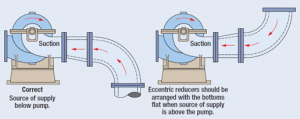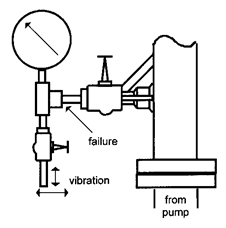Author: Heinz P. Bloch, P.E.
Flexible and expansion joints are never used in flammable, toxic or explosive services by reliability and safety-focused personnel. If there should be a fire at or near a pump equipped with flexible hose or expansion joints, these weak links will likely be the first to let go and the risk of aggravated failure and disaster would increase exponentially. We will, however, concede that not everyone is focused on safety and reliability and that talkers are often are blessed with a glib tongue. As Amoco’s Ed Nelson once said: “When it’s all said and done, more will have been said than done.”
However, there is an exception to the piping rule. In 2017, innovative mechanical seal manufacturers will point to the advantages of aircraft-type stainless steel tubing and connectors for seal auxiliaries. Be determined to work with top notch manufacturers in this regard. Steer clear of those who will not even return your phone calls; just imagine the kind of service they will provide if you make the mistake of linking up with them. Look for the “three H’s” honesty, hunger (for becoming your technology resource), and humility. A humble person will tell you what they know and don’t know. The non-humble are arrogant self-promotors whose greedy aims will sooner or later deprive you –and others—of both safety and reliability.
Again, back to our topic: Staying with pipe on process pumps is prudent. Using stainless steel tubing on mechanical seals is equally prudent. Of course the pipe must be properly installed and no dangerous shortcuts should ever be allowed. Steel tubing must involve the best and most reputable providers, but will be worth the collaborative effort. Never allow flexible piping in flammable, toxic and explosive applications. Become familiar with what happened at Flixborough in 1974 and several other locations that involved flexible joints. Free-standing or small pipe must always be braced or gusseted with a diagonal bracket or other suitable two-plane bracing or support (Figure 1). Equipment vibration tends to weaken unsupported free-standing pipes
Never use pipe for handrails. In the mid-to-late 1800s, pipe was widely used for handrails on elevated structures in the mining industry. Pipe had become readily available and the human hand can grasp handrails rather comfortably. So as to prevent rusting, the pipe was painted. But rust formed on the inside of the pipe and, unbeknownst to some workers, the pipe walls got progressively thinner. More than once, a worker leaned against the nicely painted but now weakened handrail and fell to his death. That is why pipe is not used for handrails in modern industry.
Gusseting
Bracing and gusseting are very important means of ensuring valve and instrument connections of proper strength and with lowest possible risk of vibration-induced failure. Two-plane gusseting near a pipe is shown in Figure 1; installations at pump piping must be sufficiently far away to satisfy hand clearance and maintenance access requirements. Single-plane gusseting is not sufficiently vibration resistant; it should not be used. Our professional colleague Anthony Sofronas wrote about it in three of his books and in over 100 articles that ideally combined his extensive theoretical knowledge with decades of practical experience at Exxon.
Sofronas alerts us how, at all times, the requisite material, welding technology and post-weld heat treatment (PWHT) requirements must be observed as well. In general, involvement of a competent metallurgist should be sought in the design of seemingly insignificant bypass or warmup piping for process pumps. Suffice it to say that careless piping and support routines are disproportionately responsible for many pump failure incidents.
Concentric vs. eccentric reducers
Piping reducers are generally installed at the process pump suction nozzle to transition from the larger diameter (low flow velocity, moderate friction loss) suction pipe to the pump suction nozzle. They should be installed in such a manner that trapped air or vaporized product will not accumulate in any portion of the pipe reducer.
Figures 2 and 3 serve as installation guidelines of interest.

Figure 3: If inlet flow originates above the pump suction nozzle, air or vapor pockets are avoided by using the eccentric reducer (right side of image) with the flat side down (Ref. 3)
Always remember that in a contest between the uninformed and the laws of physics, the laws of physics will win, as surely as the earth is a circle. While that is disputed by the flat-earthers, time is too short to waste on such disputes. Believe in science and do your job right. If you engage in debates with morons, you will always lose.
References
- Bloch, Heinz P. and Allan Budris; “Pump User’s Handbook: Life Extension,” 4th Edition, (2014), Fairmont Publishing, Lilburn, GA, ISBN 0-88173-720-8
- Bloch, Heinz P.; “Pump Wisdom: Problem Solving for Operators and Specialists”; (2011), Wiley & Sons, Hoboken, NJ; ISBN 9-781118-04123-9
- Bloch, Heinz P.; “Petrochemical Machinery Insights,” (2016) Elsevier Publishing, Oxford, UK, and Cambridge, MA, ISBN 978-0-12-809272-9





